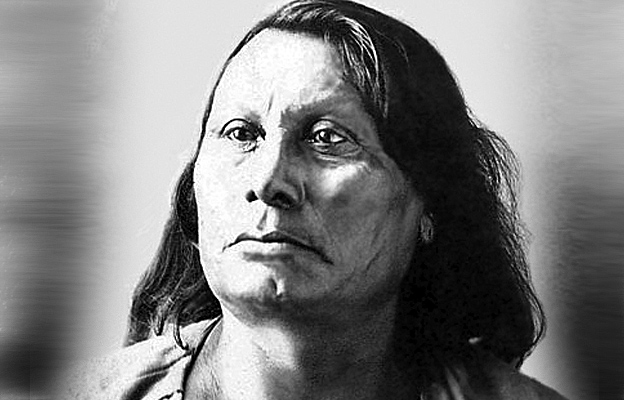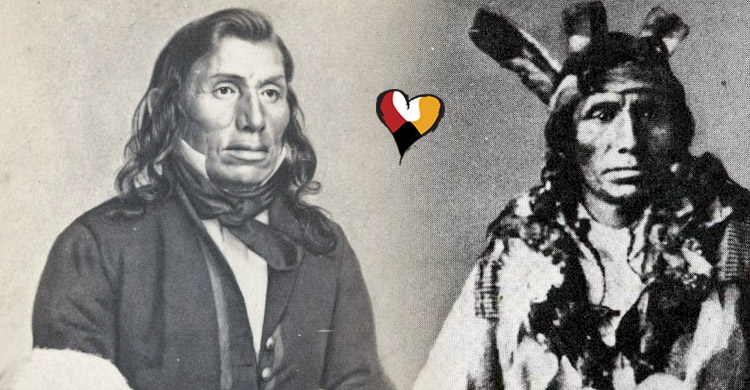Chief Gall “Indian Heroes and Great Chieftains” by Charles A. Eastman (Ohiyesa)
Chief Gall, Hunkpapa Lakota was one of the most aggressive leaders of the Sioux nation in their last stand for freedom. The westward pressure of civilization during the past three centuries has been tremendous. When our hemisphere was “discovered”, it had been inhabited by the natives for untold ages, but it was held undiscovered because the original owners did not chart or advertise it.
Yet some of them at least had developed ideals of life which included real liberty and equality to all men, and they did not recognize individual ownership in land or other property beyond actual necessity. It was a soul development leading to essential manhood. Under this system, they brought forth some striking characters. Gall was considered by both Indians and whites to be the most impressive type of physical manhood. From his picture, you can judge this for yourself.
Let us follow his trail. He was no tenderfoot. He never asked a soft place for himself. He always played the game according to the rules and to a finish. To be sure, like every other man, he made some mistakes, but he was an Indian and never acted the coward.
The earliest stories told of his life and doings indicate the spirit of the man in that of the boy.
When he was only about three years old, the Blackfoot band of Sioux was on their usual roving hunt, following the buffalo while living their natural happy life upon the wonderful wide prairies of the Dakotas.
It was the way of every Sioux mother to adjust her household effects on such dogs and pack ponies as she could muster from day to day, often lending one or two to accommodate some other woman whose horse or dog had died, or perhaps had been among those stampeded and carried away by a raiding band of Crow warriors.
On this particular occasion, the mother of our young Sioux brave, Matohinshda, or Bear-Shedding-His-Hair (Gall’s childhood name), intrusted her boy to an old Eskimo pack dog, experienced and reliable, except perhaps when unduly excited or very thirsty.
On the day of removing the camp, the caravan made its morning march up the Powder River. Upon the wide table-land, the women were busily digging teepsinna (an edible sweetish root, much used by them) as the moving village slowly progressed.
As usual, at such times, the trail was wide. An old jackrabbit had waited too long in hiding. Now, finding himself almost surrounded by the mighty plains people, he sprang up suddenly, his feathery ears conspicuously erect, a dangerous challenge to the dogs and the people…
A whoop went up. Every dog accepted the challenge. Forgotten were the bundles, the kits, even the babies they were drawing or carrying. The chase was on, and the screams of the women reechoed from the opposite cliffs of the Powder, mingled with the yelps of dogs and the neighing of horses. The hand of every man was against the daring warrior, the lone Jack, and the confusion was great.
When the fleeing one cleared the mass of his enemies, he emerged with a swiftness that commanded respect and gave promise of a determined chase. Behind him, his pursuers stretched out in a thin line, first the speedy, unburdened dogs and then the travois dogs headed by the old Eskimo with his precious freight. The youthful Gall was in a travois, a basket mounted on trailing poles and harnessed to the sides of the animal.
“Hey! hey! they are gaining on him!” a warrior shouted. At this juncture, two of the canines had almost nabbed their furry prey by the back. But he was too cunning for them. He dropped instantly and sent both dogs over his head, rolling and spinning, then made another flight at right angles to the first. This gave the Eskimo a chance to cut the triangle.
He gained fifty yards, but being heavily handicapped, two unladen dogs passed him. The same trick was repeated by the Jack, and this time he saved himself from instant death by a double loop and was now running directly toward the crowd, followed by a dozen or more dogs. He was losing speed, but likewise, his pursuers were dropping off steadily.
Only the sturdy Eskimo dog held to his even gait, and behind him in the frail travois leaned forward the little Matohinshda, nude save a breechclout, his left hand holding fast the convenient tail of his dog, the right grasping firmly one of the poles of the travois. His black eyes were bulging almost out of their sockets; his long hair flowed out behind like a stream of dark water.

The Jack now ran directly toward the howling spectators, but his marvelous speed and alertness were on the wane; while on the other hand his foremost pursuer, who had taken part in hundreds of similar events, had every confidence in his own endurance.
Each leap brought him nearer, fiercer and more determined. The last effort of the Jack was to lose himself in the crowd, like a fish in muddy water; but the big dog made the one needed leap with unerring aim and his teeth flashed as he caught the rabbit in viselike jaws and held him limp in air, a victor!
The people rushed up to him as he laid the victim down, and foremost among them was the frantic mother of Matohinshda or Gall. “Michinkshe! michinkshe!” (My son! my son!) she screamed as she drew near. The boy seemed to be none the worse for his experience. “Mother!” he cried, “my dog is brave: he got the rabbit!” She snatched him off the travois, but he struggled out of her arms to look upon his dog lovingly and admiringly.
Old men and boys crowded about the hero of the day, the dog, and the thoughtful grandmother of Matohinshda unharnessed him and poured some water from a parfleche water bag into a basin. “Here, my grandson, give your friend something to drink.”
“How, hechetu,” pronounced an old warrior no longer in active service. “This may be only an accident, an ordinary affair; but such things sometimes indicate a career. The boy has had a wonderful ride. I prophesy that he will one day hold the attention of all the people with his doings.”
This is the first remembered story of the famous chief, but other boyish exploits foretold the man he was destined to be. He fought many sham battles, some successful and others not; but he was always a fierce fighter and a good loser.
Once he was engaged in a battle with snowballs. There were probably nearly a hundred boys on each side, and the rule was that every fair hit made the receiver officially dead. He must not participate further but must remain just where he was struck.
Gall’s side was fast losing, and the battle was growing hotter every minute when the youthful warrior worked toward an old water hole and took up his position there. His side was soon annihilated and there were eleven men left to fight him. He was pressed close in the wash-out, and as he dodged under cover before a volley of snowballs, there suddenly emerged in his stead a huge gray wolf.
His opponents fled in every direction in superstitious terror, for they thought he had been transformed into the animal. To their astonishment, he came out on the farther side and ran to the line of safety, a winner! It happened that the wolf’s den had been partly covered with snow so that no one had noticed it until the yells of the boys aroused the inmate, and he beat a hasty retreat. The boys always looked upon this incident as an omen.
Gall had an amiable disposition but was quick to resent insult or injustice. This sometimes involved him in difficulties, but he seldom fought without good cause and was popular with his associates. One of his characteristics was his ability to organize, and this was a large factor in his leadership when he became a man.
He was tried in many ways and never was known to hesitate when it was a question of physical courage and endurance. He entered the public service early in life, but not until he had proved himself competent and passed all tests.
When a mere boy, he was once scouting for game in midwinter, far from camp, and was overtaken by a three days’ blizzard. He was forced to abandon his horse and lie under the snow for that length of time. He afterward said he was not particularly hungry; it was thirst and stiffness from which he suffered most. One reason the Indian so loved his horse or dog was that at such times the animal would stay by him like a brother.
On this occasion, Gall’s pony was not more than a stone’s throw away when the storm subsided and the sun shone. There was a herd of buffalo in plain sight, and the young hunter was not long in procuring a meal.
This chief’s contemporaries still recall his wrestling match with the equally powerful Cheyenne boy, Roman Nose, who afterward became a chief well known to American history. It was a custom of the northwestern Indians, when two friendly tribes camped together, to establish the physical and athletic supremacy of the youth of the respective camps.
The “Che-hoo-hoo” is a wrestling game in which there may be any number on a side, but the numbers are equal. All the boys of each camp are called together by a leader chosen for the purpose and draw themselves up in line of battle; then each at a given signal attacks his opponent.
In this memorable contest, Matohinshda, or Gall, was placed opposite Roman Nose. The whole people turned out as spectators of the struggle, and the battlefield was a plateau between the two camps, in the midst of picturesque Bad Lands. There were many athletic youths present, but these two were really the Apollos of the two tribes.
In this kind of sport it is not allowed to strike with the hand, nor catch around the neck, nor kick, nor pull by the hair. One may break away and run a few yards to get a fresh start, or clinch, or catch as catch can. When a boy is thrown and held to the ground, he is counted out. If a boy has met his superior, he may drop to the ground to escape rough handling, but it is very seldom one gives up without a full trial of strength.
It seemed almost like a real battle, so great was the enthusiasm, as the shouts of sympathizers on both sides went up in a mighty chorus. At last, all were either conquerors or subdued except Gall and Roman Nose. The pair seemed equally matched. Both were stripped to the breechclout, now tugging like two young buffalo or elk in mating time, again writhing and twisting like serpents.
At times they fought like two wild stallions, straining every muscle of arms, legs, and back in the struggle. Every now and then one was lifted off his feet for a moment, but came down planted like a tree, and after swaying to and fro soon became rigid again.
All eyes were upon the champions. Finally, either by trick or main force, Gall laid the other sprawling upon the ground and held him fast for a minute, then released him and stood erect, panting, a master youth. Shout after shout went up on the Sioux side of the camp.
The mother of Roman Nose came forward and threw a superbly worked buffalo robe over Gall, whose mother returned the compliment by covering the young Cheyenne with a handsome blanket.
Undoubtedly these early contests had their influence upon our hero’s career. It was his habit to appear most opportunely in a crisis, and in a striking and dramatic manner to take command of the situation. The best-known example of this is his entrance on the scene of confusion when Reno surprised the Sioux on the Little Big Horn.
Many of the excitable youths, almost unarmed, rushed madly and blindly to meet the intruder, and the scene might have unnerved even an experienced warrior. It was Gall, with not a garment upon his superb body, who on his black charger dashed ahead of the boys and faced them. He stopped them on the dry creek, while the bullets of Reno’s men whistled about their ears.
“Hold hard, men! Steady, we are not ready yet! Wait for more guns, more horses, and the day is yours!”
They obeyed, and in a few minutes the signal to charge was given, and Reno retreated pell-mell before the onset of the Sioux.
Sitting Bull had confidence in his men so long as Gall planned and directed the attack, whether against United States soldiers or the warriors of another tribe. He was a strategist, and able in a twinkling to note and seize upon an advantage. He was really the mainstay of Sitting Bull’s effective last stand. He consistently upheld his people’s right to their buffalo plains and believed that they should hold the government strictly to its agreements with them.
When the treaty of 1868 was disregarded, he agreed with Sitting Bull in defending the last of their once vast domain, and after the Custer battle entered Canada with his chief. They hoped to bring their lost cause before the English government and were much disappointed when they were asked to return to the United States.
Gall finally reported at Fort Peck, Montana, in 1881, and brought half of the Hunkpapa band with him, whereupon he was soon followed by Sitting Bull himself. Although they had been promised by the United States commission who went to Canada to treat with them that they would not be punished if they returned, no sooner had Gall come down than a part of his people were attacked, and in the spring they were all brought to Fort Randall and held as military prisoners. From this point, they were returned to Standing Rock agency.
When “Buffalo Bill” successfully launched his first show, he made every effort to secure both Sitting Bull and Gall for his leading attractions. The military was in complete accord with him in this, for they still had grave suspicions of these two leaders. While Sitting Bull reluctantly agreed, Gall haughtily said: “I am not an animal to be exhibited before the crowd,” and retired to his teepee.
His spirit was much worn, and he lost strength from that time on. That superb manhood dwindled, and in a few years, he died. He was a real hero of free and natural people, a type that is never to be seen again.
“Indian Heroes and Great Chieftains” by Charles A. Eastman (Ohiyesa)
(Google Book Chief Gall and others)






